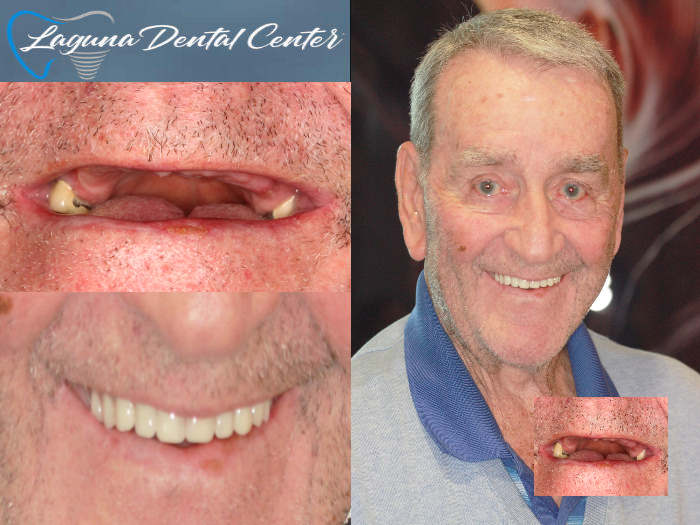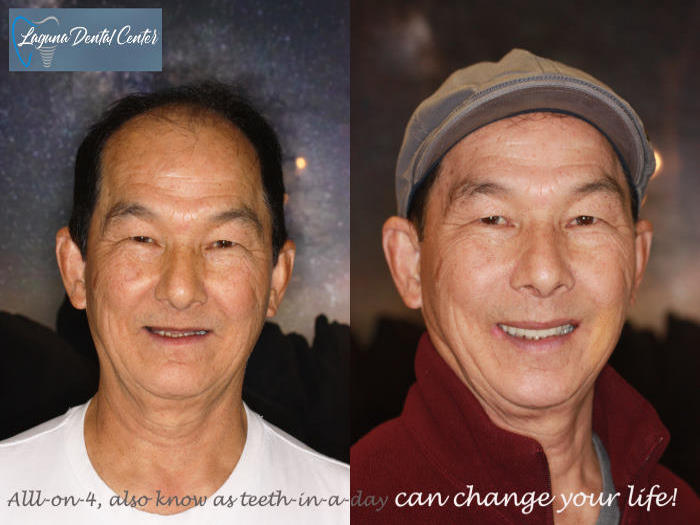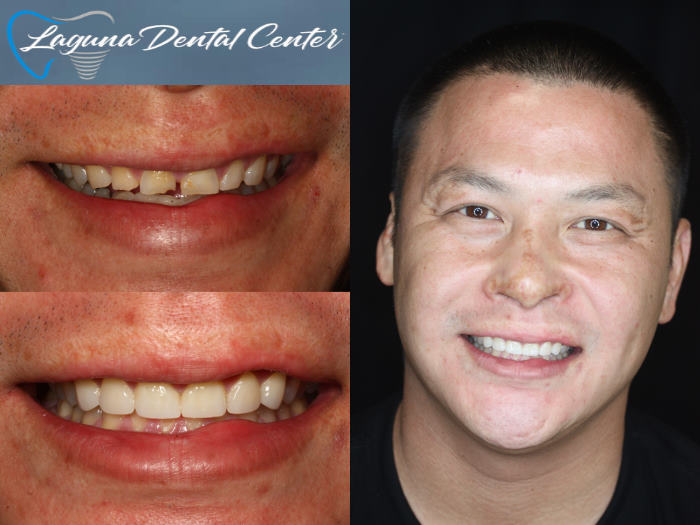Table of Contents
Laguna Dental Center offers dental implants to replace missing teeth. You no longer have to worry about your teeth when you eat or speak or even worry about the gaps when you smile. You can eat whatever you desire without worrying about damaging your fixed artificial teeth. Dental implants are metal posts that resemble screws, with crowns on top. They are surgically inserted medical devices that are placed in the jaw and support one or more prosthetic teeth or crowns, which helps to restore oral health and functionality. Get a free 30 minute consultation with Dr. Ronald Ayzin for dental implants in Lake Forest. Dr. Ronald Ayzin will perform a comprehensive exam for dental implant Lake Forest. Live your life better and healthier by having a permanent teeth restoration at Laguna Dental Center Dental Office.
Why Dental Implants?
Laguna Dental Center provides patients in Lake Forest, CA low cost, state-of-the-art dental implants which look and function as normal teeth. Dr. Ronald Ayzin, as a dental implant expert since 2016, has helped more than 300 patients gain a healthy, even smile with restorative dental implants. We are near you, please call (949) 704-6269 to schedule an appointment. Call our office in Lake Forest for an unsurpassed tooth implanting experience.
Dental implants replace missing, severely damaged, or rotting teeth with a permanent solution that never needs to be removed or replaced but is simply cared for as you would your natural teeth. Dental implants are more expensive than other tooth replacement options, but they endure a long time and are worthwhile investments.
Am I a good Candidate for Dental Implants in Lake Forest?
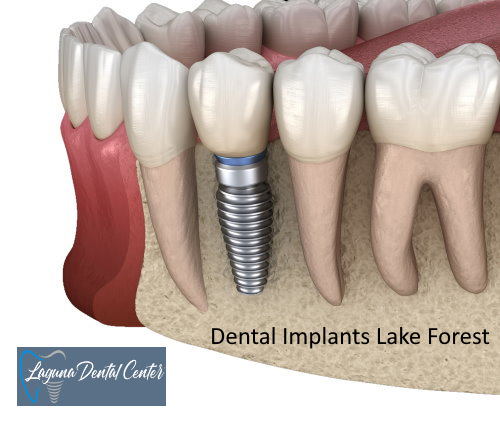
Laguna Dental Center Dental Implants for Lake Forest Community
You are a good candidate for dental implants if you have good overall oral hygiene and are healthy. Below is a list of other qualifications you should have in order to have a successful dental implant procedure.
- You should not have periodontal disease.
- You should be committed to performing the maintenance necessary for a successful implant, such as brushing and flossing your teeth regularly and going to all of your post-surgical visits and consultations.
- You should have enough bone density present in your jaw, or with the help of a bone graft have enough density to support your implant.
- You should have enough room in the upper jaw oral cavity if a dental implant is required there, or be able to gain enough room with a sinus lift.
- You should not smoke, or should be willing to stop smoking during the osseointegration period.
- You should have medical conditions, including diabetes, under control with medication, and ensure with your physician that this procedure will not lead to any oral and maxillofacial surgery risk.
Does my dental insurance cover dental implant surgery?
Dental insurance coverage for implants depends on your individual dental insurance plan. Most PPO dental insurance plans cover some of the costs of implant surgery, but the amount varies depending on the specific plan. You should contact your insurance provider to determine what is covered.
Why choose a tooth implant over a natural tooth-supported bridge?
Replacing a missing tooth with a tooth-supported bridge can have some serious drawbacks. The dentist must grind down the enamel of the two adjacent teeth in order to fix the bridge in place, which can lead to decay of those teeth. Furthermore, due to the lack of force applied to the bone, it can start to melt away, resulting in destabilization of the adjacent teeth, hygiene issues, and cosmetic challenges. A dental implant, on the other hand, recreates the natural anatomy and applies force to the bone, preserving it and avoiding damage to adjacent teeth.
What’s more, research shows that tooth-supported bridges tend to fail within 15 years, while the majority of implants, when integrated, last a lifetime. Additionally, removable bridges and Maryland bridges (or resin bonded) are not very attractive choices and do not address the bone loss problem, making them less desirable. Thus, a dental implant is the best choice to replace a missing tooth, as it offers a long-term solution and is more cost-effective in the long run.
How long do Dental Implants last?
Dental implants last a lifetime. For replacing lost teeth, dental implants are the longest-lasting restoration available near Lake Forest. Research shows that the success rate of implants, in the long run, is over 95%. See below for a comparison chart of the most common teeth replacement options for Lake Forest, CA.
| Tooth replacement technologies | ||||
| Flipper | Dentures | Bridge | Implants | |
| Longevity | 1-3 years | 5-7 years | 7-10 years | Lifetime |
| Preservation of healthy adjacent teeth | Yes | Yes | No | Yes |
| Transmission of force to: | Adjacent teeth | Adj teeth/gums | Adjacent teeth | Bone |
| Prevent bone loss & preserve facial appearance | No | No | No | Yes |
| Requirement for periodic adjustments | Yes | Yes | Yes | No |
| Accelerated loss of adjacent teeth | Yes | Yes | Yes | No |
| Source: Premium Tooth Replacement, Deutsche Bank, January 26, 2006 | ||||
How much do Dental Implants cost in Lake Forest, CA?
A single tooth implant cost in Lake Forest, CA ranges between $2,000 and $5,800. This includes the dental implant cost, abutment, crown, and other procedures such as imaging.
How much do Same day dental implants Cost in Lake Forest?
Same day dental implant cost ranges between $4,000 and $6,500 per implant in Lake Forest, CA.
How much does a Full Mouth Dental Implant Cost in Lake Forest?
Full mouth dental implant cost range falls between $60,000 to $90,000. Two full arches of false teeth which are anchored on four or more implants in each jaw, called implant-supported dentures, range between $24,000 and $50,000 for a complete set in Lake Forest, CA.
Why choose Laguna Dental Center for dental implant surgery?
Dr. Ronald Ayzin has restored the smiles of more than 300 of his patients using dental implants. Since becoming certified in 2016, he has been established as a dental implants expert in and near Lake Forest, CA. He enjoys helping his patients get the healthy smile they desire, using the latest dental implant technology to make things comfortable and pain-free. Laguna Dental Center will give you a free consultation and free X-ray to see if dental implants are an option for you and answer your questions about the procedure.
What does a Dental Implant look like?
A dental implant has the appearance of a long metal post, between 7 and 16 mm long, and is made up of the fixture, abutment, and crown. The main part of the implant is the titanium post, also known as the fixture. The implant has a few tiny pinholes at the bottom of the post to aid in the osseointegration process. The screw that secures a dental crown in place is held in place by the abutment, which acts as the top of the implant. The connector also referred to as a screw, holds the dental crown in place.
Dental Implant Before and After Photos
Make an Appointment with Dr. Ronald Ayzin for Dental Implants Consultation near Lake Forest
Laguna Dental Center provides the best quality dental implants at a cost that our neighbors and nearby patients in Lake Forest, CA can afford. Don’t spend another day with missing teeth. Our dental implant specialist Dr. Ronald Ayzin, DDS is near you and can give you the smile you have always wanted.
Contact Us:
Full Mouth Dental Implants Lake Forest
Dental implants for the whole mouth are made to replace most or all of your teeth. These Teeth Implants are a great alternative to Dentures when teeth need to be replaced so that you can speak, eat, and smile with confidence. Per row of replacement teeth, 4 to 8 implants are utilized. There are multiple kinds of whole-mouth dental implants available to Lake Forest Community for the replacement of some or all lost teeth, including All on 4 implants, same-day full-mouth dental implants, implant-supported dentures, and zirconia full arch.
Dental Implant in a Day (Same Day Dental Implants) Lake Forest
Same-day Dental Implants may often be accomplished in a single session lasting anywhere from 30 minutes to 3 hours, depending on the number of implanted teeth. An initial appointment to see whether you’re a suitable candidate for same-day dental implants, the actual operation, and a check-up thereafter are all part of the process. However, your implant dentist will only need to schedule one visit for the actual implant operation. Nevertheless, your gums and jaw still require some time to recover before acquiring crowns. Temporary teeth will be given to you on the day of your procedure. After your mouth has fully healed, permanent teeth will be given to you in lieu of temporary ones.
What is a Dental Implant?
A dental implant is a metal rod inserted into your jaw to serve as an artificial tooth root. They are constructed of titanium and are available in various shapes and sizes (diameter & length). Once the implant is inserted, osseointegration, the process by which a dental implant heals and fuses with the jawbone after being implanted, will take place over a period of 3 to 6 months. Once the implant has successfully integrated into the jaw, the abutment and dental crown will be positioned, restoring your ability to chew, speak and smile.
What are Different Types of Dental Implants?

Subperiosteal implants are inserted beneath the gum line, but on or above the jawbone. A patient without enough healthy jawbone to support the dental implant and cannot or does not want to undergo bone augmentation treatment may be able to use this type of teeth implant.
What are steps for Dental Implant placement?
There are four steps for the dental implant procedure at Laguna Dental Center. First, Dr. Ronald Ayzin examines your teeth, gums, and jaw to see if you are a suitable candidate for dental implant surgery. If your jawbone is insufficient, Dr. Ronald Ayzin performs a bone graft that will heal for several weeks before the dental implant procedure can be done. Second, the titanium posts will be placed in your jawbone. Third, you’ll experience a healing period of around two to six months as osseointegration occurs, and new bone develops around the artificial tooth’s root. During the healing period, the crown will be fabricated to match your other teeth in size and color. The fourth and final step is to insert the abutment and crown over the post.
FAQs for Dental Implants in Lake Forest
How long after dental implants can I eat normally?
After dental implant surgery in Lake Forest, you might be able to drink and eat something soft about an hour to two hours later. You should only eat soft meals for the first 24 hours. For the first three days, refrain from using a straw, and for several hours after, stay away from hot meals and beverages. Remember not to chew crunchy or hard foods for the following several months while the implants are integrating and while sporting a temporary crown as this can impede the healing process.
Can you break an implant tooth?
Yes, you can break an implant tooth. Despite the fact that dental implants are designed to be as durable as natural teeth, full healing of the implant requires many months. The titanium replacement tooth root is placed into the jawbone. Even though it is more durable than a real tooth root, it needs to be given time to fully bond with the jawbone. In the event that there is mouth trauma, the abutment screw may get bent or fractured. Although the dental crown is likewise highly sturdy, it has a similar breaking point to a normal tooth.
About Lake Forest
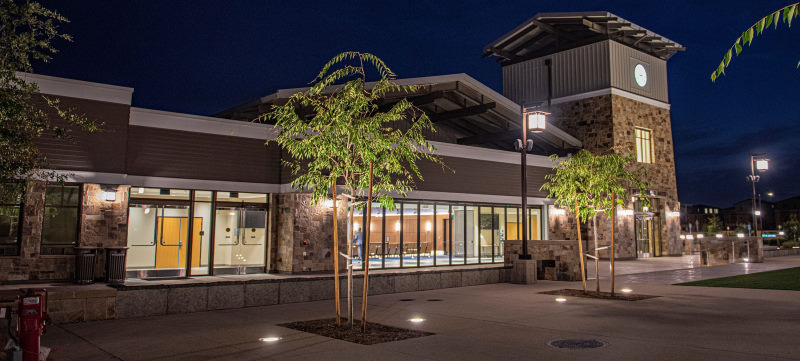
Lake Forest incorporated as a city on December 20, 1991. Prior to incorporation, the community had been known as El Toro. Following a vote in 2000, Lake Forest expanded its city limits to include the master-planned developments of Foothill Ranch and Portola Hills. This expansion brought new homes and commercial centers to the northeastern boundary of the city.
Lake Forest has two lakes from which the city gets its name. The lakes are man-made, and condominiums and custom homes ranging from large to small line their shores. Neighborhood associations manage the lakes (Lake 1, known as the Lake Forest Beach and Tennis Club, and Lake 2, the Sun and Sail Club.) Each facility features tennis courts, gyms, basketball courts, barbecue pits, volleyball courts, multiple swimming pools, saunas, hot tubs and club houses for social events.
According to the United States Census Bureau, the city has a total area of 17.9 square miles (46 km2). 17.8 square miles (46 km2) of it is land and 0.1 square miles (0.26 km2) of it (0.48%) is water.
Lake Forest is bordered by Irvine on the west and northwest, Laguna Woods and Laguna Hills are located on the southwest, Mission Viejo on the southeast, Trabuco Canyon and Silverado Canyon on the east, and Limestone Canyon Regional Park on the north.
Lake Forest is located in the heart of the Saddleback Valley, the north-east end located in the Foothills of the Santa Ana Mountains. It is also in the northern section of South Orange County.
The 2020 United States Census reported a population of 85,858.
Lake Forest is served by two branches of the Orange County Public Library system known as OC Public Libraries: the El Toro branch and the Foothill Ranch branch.
The city is the location of Rick Warren’s megachurch, Saddleback Church, the eighth-largest church in the United States.
The city of Lake Forest puts on an annual summer concert at Pittsford Park. Other public events include the Fourth of July 5K run and fireworks display over the lake at the Sun & Sail Club. Source: (Wikipedia)

